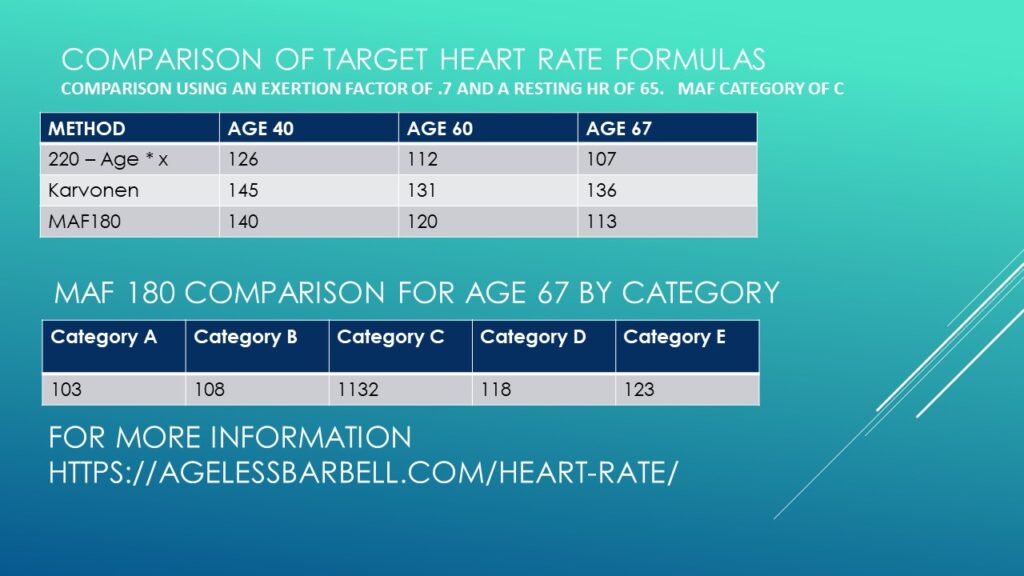Heart Rate
METRICS for HEALTH
What do you measure?
• Weight
• Blood Pressure
• Heart Rate during exercise
• Exercise duration
• Sets/Reps/Weight used
• Food intake: Calories/Macros/Micronutrients
What about Resting Heart Rate?
Did you know that resting heart rate is important for more than determining your Target Heart Rate for cardio training? That’s correct. Just as you monitor your weight, blood pressure, food intake, and quantity of exercise you should monitor your resting heart-rate. It is important to everyone, not just athletes. A higher than normal resting heart-rate can warn you of a pending problem. Bottom line – it is important to measure your resting heart-rate at regular intervals. Let’s get started.
Tools needed: A heart-rate monitor. These are easy to find these days and come in many forms and prices:
• A watch with a sensor
• A sensor in the form of a chest strap with a receiving device
• Fingertip oximeter with heart-rate monitor
BEST TIME: upon waking.
LYING or SITTING: It does not matter as long as you do it the same way each time. Be consistent. Note that sitting heart-rates are 1-2 beats higher than lying hear-rates.
HOW TO TAKE: Strap on the Heart Rate monitor. If you had to move around to find it lie still for 5 minutes before starting the monitor. Stay still and record your heart-rate for 30 seconds. Take the lowest number.
Your Resting heart-rate should vary only by a couple of beats on consecutive days.
Change in resting heart-rate by more than a few beats can signal:
• Stress
• Cold or Flu
• Infection
• Allergies
• More serious problems
According to Dr. Phil Maffetone:
The resting heart rate assessment for active individuals — this includes cardiovascular and other disease risks:
• Up to 65 — low risk
• 66-79 — moderate risk
• 80 and above — high risk
TARGET HEART RATE
I thought I would get a little vitamin D and let the dogs play while I talk to you about Target Heart Rate.
We have discussed that to stay healthy you need 150 to 300 minutes of moderate intensity cardio per week. How do you measure moderate intensity? It is measured based on either your perceived exertion during the exercise or more accurately by Target Heart Rate.
The American Heart association recommends a target heart rate of :
- Moderate exercise intensity: 50% to about 70% of your maximum heart rate
- Vigorous exercise intensity: 70% to about 85% of your maximum heart rate
The most accurate way to determine max heart rate is via a VO2 Max test in a lab with highly trained individuals. This is quite expensive. Additionally, there are tests that can be done on the track or on your bike to determine your zones and these will be discussed in a later video.
For now, let’s look at simple ways to determine a target heart rate zone and range. I use a low range of 10 bpm lower than the target HR.
- RPE – Perceived Exertion – Based on the Borg Scale developed by Dr. Gunnar Borg.
- Very Light – Folding clothes
- Light – Something you can continue for hours. Easy to breathe and carry on conversation 20 -50 %
- Moderate – Breathing Heavily. You can still hold conversation. Comfortable but challenging.
- Vigorous – Short of Breath. Can speak a sentence.
- Very Hard – Can barely breathe. Legs are screaming. Grunting now. Please make it stop.
- Max – Almost impossible. Going to pass out. Cannot even grunt.
- The 220 method. This is the simplest method but not accurate since heartrate does not necessarily change with age. Often estimates are too high for younger people and too low for older people. Everyone is not the same. The calculation is THR = (220 – age) * exertion factor. We are using a .7 for exertion factor since it is the high end of what the American Heart Association describes as moderate.
- The Karvonen Method developed by Dr Martti Karvonen in the 1950s uses (((220 – age) – resting HR ) * exertion factor) + Resting HR)
- The MAF 180 developed by Dr. Phil Maffetone in the 1980s as an alternative to the Karvonen Method which was thought to be too high. It uses (180 – age) then modifies based on health factors:
- If you have or are recovering from a major illness (including any operation or hospital stay), are in rehabilitation, have been prescribed any regular medication, or are chronically overtrained, subtract an additional 10.
- If you are injured, have regressed or not improved in training or competition, get more than two colds, flu or other infections per year, have seasonal allergies or asthma, are overfat, are acutely overtraining, or if you have been inconsistent, just beginning or returning to exercise, subtract an additional 5.
- If you have been training consistently (at least four times weekly) for up to two years without any of the problems mentioned in a) or b), no modification is necessary (use 180 minus age as your MAF HR).
- If you have been training for more than two years without any of the problems listed above, have made progress in your MAF Tests, and have improved competitively, add 5.
- Over 65 in category d can add 10 based on good self assessment
- Age 16 and under use 165

